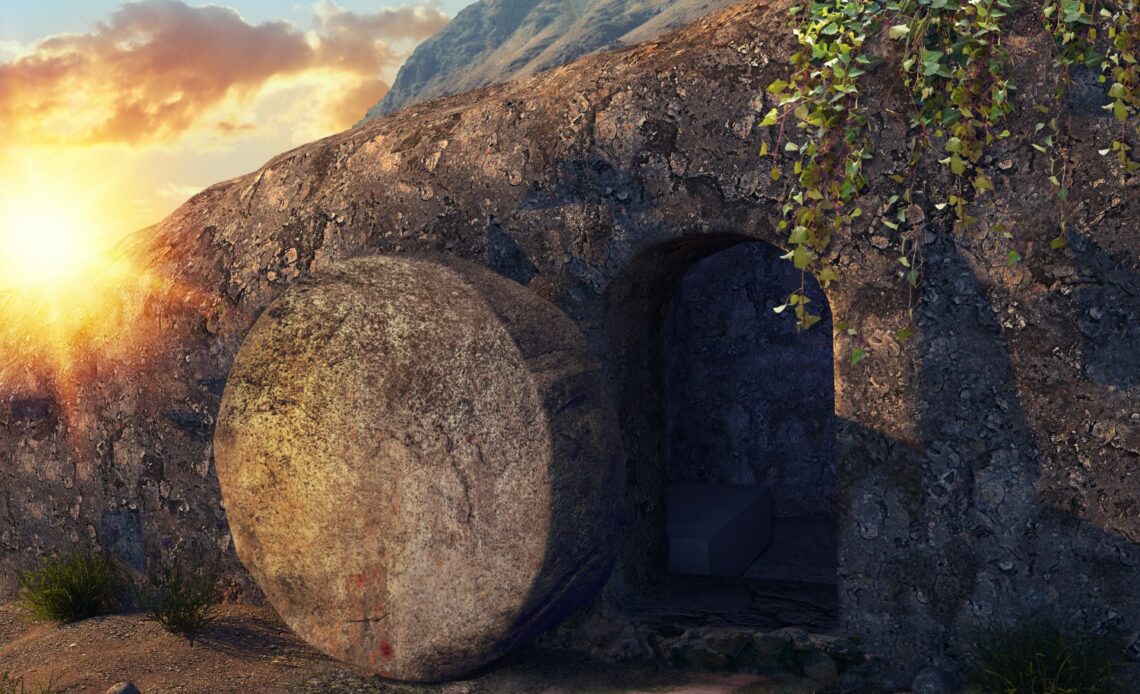Whether you have been a follower of Christ for decades, or you’re new to the faith, you have likely heard or read the story of the first Easter. The resurrection of Christ has been the focus of countless sermons over thousands of years. It has been depicted in movies, TV shows, and literature. It has been the source of worship songs. It is one of the most famous stories ever told, and it is 100% true.
However, there are a few details of the Easter story that are often overlooked. Today, we’re going to look at four events from the first Easter that you may have missed over the years. Allow the story to become new to you all over again on this Easter Sunday.
Matthew 28:2-4 (TPT)
Suddenly, the earth shook violently beneath their feet as the angel of Yahweh descended from heaven. Lightning flashed around him and his robe was dazzling white! The guards were stunned and terrified-lying motionless like dead men. Then the angel walked up to the tomb, rolled away the stone, and sat on top of it.
Each of the four Gospel accounts talk about the conversation between the women when they were on their way to the tomb. While most of the focus is on their conversations, and the conversation that they had with the angels after they got there, we often overlook a powerful aspect of the story. The stone was rolled away after Jesus had resurrected.
What does that mean for us? It means that the stone wasn’t rolled away so Jesus could get out. It was rolled away so the believers could get in. In John 19:20, we find that Jesus walked through a locked door to appear to His disciples. That means that in His glorified state, He walked out of the tomb before the stone was rolled away.
The empty tomb was an invitation to the women who went to anoint His body. The empty tomb was an invitation for the disciples who would come later in the day. The empty tomb is an invitation to us to come and see that He is alive and we can live also!
Mark 16:6-7 (TPT)
But the angel said to them, “Don’t be afraid. I know that you’re here looking for Jesus of Nazareth, who was crucified. He isn’t here-he has risen victoriously! Look! See the place where they laid him. Run and tell his disciples, even Peter, that he is risen. He has gone ahead of you into Galilee and you will see him there, just like he told you.”
On the morning of the first Easter, there were still 11 disciples. We know that Judas, overcome by guilt and shame by his betrayal of Christ, had hung himself. However, the rest of the disciples were together, hiding in a room because they feared for their own lives. Some of them hadn’t seen Christ since the night of His arrest. Peter hadn’t seen Him since Peter’s third denial. John was there when He took His last breath. Undoubtedly, they were all replaying the last time they had seen their Savior and Friend.
While most of the disciples may have been dealing with regret for leaving Jesus when He needed them most, Peter undoubtedly had the most guilt. He had declared that Jesus was wrong about him denying Him, and then, he cracked under pressure. With his third denial, Peter and Jesus locked eyes. Shame, regret, remorse, and every other negative emotion must have flowed through Peter.
That is why the angel, who had been sent by God, made sure to tell the women to tell Peter that Jesus was alive. Peter was likely questioning his calling as a disciple. If he couldn’t even admit to knowing Christ, could God still use him? God made sure to let Peter know that he was still part of the plan.
The command to tell the disciples, “even Peter,” that Christ would meet with them is a powerful reminder that God doesn’t give up on us at our lowest moments.
Luke 24:14-16 (TPT)
They were in the midst of a discussion about all the events of the last few days when Jesus walked up and accompanied them in their journey. They were unaware that it was actually Jesus walking alongside them, for God prevented them from recognizing them.
The story of Christ meeting with two followers on the road to Emmaus is only found in Saint Luke’s Gospel. It is also the source of much debate, as the names of these two disciples aren’t given in Scripture. We do know that they weren’t members of the 12 disciples, as they were in Galilee and Emmaus was some seven miles away.
The conversation that this pair had with Christ is one of the most interesting in Scripture. They were talking about the events of the last few days when suddenly, a stranger appeared. The Bible says God prevented them from recognizing Him. This is likely because Christ’s glorified body was different than His natural body. When He started asking them questions about what they had seen, they were amazed. Had this man somehow avoided all the news floating around the city? What kind of stranger was this?
Over the next few miles, Christ began presenting the Gospel to them beginning with Moses and going through the events of Good Friday. When they invited Him into their homes, He went. There, He broke the bread, blessed it, and then vanished. That’s when they figured out who He was.
This story teaches us that God appears to us in ways that we often fail to recognize. We all face times where we feel alone, confused, and scared just like these early believers were. In those moments, He is there, even if you don’t see it.
John 20:6-7 (TPT)
Then Peter came behind him and went right into the tomb. He too noticed the linen clothes lying there, but the burial cloth that had been on Jesus’ head had been rolled up and placed separate from the other clothes.
Our final example of an often overlooked part of the Easter story takes place back at the tomb. When the women who had gone to anoint Jesus ran to tell the disciples that He was gone, Peter and John took off. They ran to the tomb, and as they got closer, John passed Peter. Can you imagine what was going through Peter’s mind? He had denied knowing Jesus, but the women had delivered the message of the angel, specifically letting him know that Christ wanted to see him.
In order to understand the power of this passage from John, we must consider the cultural context of the time. While the burial cloths, large strips that were wrapped around bodies, were laying in one place, the napkin that was over His face was laid to the side, neatly folded.
According to Jewish custom, a folded napkin was symbolic. When someone was eating dinner but had to step away from the table, what they did with the napkin was very telling. If they wadded the napkin up and laid it down, they were done with their meal and wouldn’t be coming back to the table. However, if the napkin was folded, it was an announcement of the diner’s intentions to return to the table.
When Peter picked up the folded napkin, he knew what it meant. Jesus had told the women to make sure Peter knew that He was alive because He knew Peter would come to the tomb. He left the napkin folded as a way of telling Peter, “I’m going to come back just like I said I would.”
The folded napkin continues to give us peace of mind. Because of Christ’s resurrection, we can embrace the promise of a resurrection and eternal life. The napkin was folded, the tomb was empty, and Christ will return for His people!
A Closing Prayer:
Heavenly Father, thank You for the power of the first Easter Sunday. Help me to recognize Your power and presence in every area of my life. Thank You for raising Your Son so that I could have eternal life. In Christ’s name, Amen.


